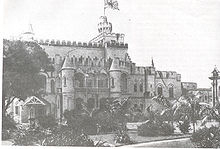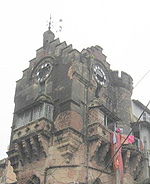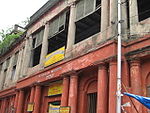
Pathuriaghata
Encyclopedia




Kolkata
Kolkata , formerly known as Calcutta, is the capital of the Indian state of West Bengal. Located on the east bank of the Hooghly River, it was the commercial capital of East India...
, earlier known as Calcutta, in the India
India
India , officially the Republic of India , is a country in South Asia. It is the seventh-largest country by geographical area, the second-most populous country with over 1.2 billion people, and the most populous democracy in the world...
n state
States and territories of India
India is a federal union of states comprising twenty-eight states and seven union territories. The states and territories are further subdivided into districts and so on.-List of states and territories:...
of West Bengal
West Bengal
West Bengal is a state in the eastern region of India and is the nation's fourth-most populous. It is also the seventh-most populous sub-national entity in the world, with over 91 million inhabitants. A major agricultural producer, West Bengal is the sixth-largest contributor to India's GDP...
. It is one of the oldest residential areas in what was Sutanuti
Sutanuti
Sutanuti was one of the three villages which were merged to form the city of Kolkata in India. The other two villages were Gobindapur and Kalikata. Job Charnock, an administrator with the British East India Company is traditionally credited with the honour of founding the city...
. Once the abode of the Bengali
Bengali people
The Bengali people are an ethnic community native to the historic region of Bengal in South Asia. They speak Bengali , which is an Indo-Aryan language of the eastern Indian subcontinent, evolved from the Magadhi Prakrit and Sanskrit languages. In their native language, they are referred to as বাঙালী...
rich, the neighbourhood and its surrounding areas are now dominated by Marwaris
Marwaris
Marwari or Marwadi or Rajasthani people are Indian ethnic group, that inhabit the Rajasthan region of India. Their language Rajasthani is a part of the western group of Indo-Aryan languages....
. Even in the 21st century the area is replete with colonnade
Colonnade
In classical architecture, a colonnade denotes a long sequence of columns joined by their entablature, often free-standing, or part of a building....
d mansions.
The Tagores
Amongst the oldest and most renowned residents of the neighbourhood were the TagoresTagore family
The Tagore family, with over three hundred years of history, has been one of the leading families of Kolkata, and is regarded as a key influence during the Bengal Renaissance...
. Joyram Tagore, who amassed a large fortune as a merchant and as Dewan to the French government at Chandannagar
Chandannagar
Chandannagar, formerly known as Chandernagore or Chandernagar , is a small city and former French colony located north of Kolkata, in West Bengal, India. It is head quarters of a subdivision in Hooghly District. It is one of the 6 municipal corporations in West Bengal. It is a part of the area...
, shifted from Gobindapur
Gobindapur
Gobindapur was one of the three villages which were merged to form the city of Kolkata in India. The other two villages were Kalikata and Sutanuti...
to Pathuriaghata, when the British constructed new Fort William
Fort William, India
Fort William is a fort built in Calcutta on the Eastern banks of the River Hooghly, the major distributary of the River Ganges, during the early years of the Bengal Presidency of British India. It was named after King William III of England...
in mid eighteenth century. There is a road named after his son, Darpanarayan Tagore (1731-1793), considered by many as the founder of the Tagore family. It is between Maharshi Debendra Road and Jadulal Mullick Road in Ward 21 of Kolkata Municipal Corporation. That is just off Pathuriaghata, but under Jorabagan
Jorabagan
Jorabagan is a neighbourhood in north Kolkata, earlier known as Calcutta, in the Indian state of West Bengal. As a neighbourhood, it covers a small area but its importance is primarily because of the police stationand the assembly constituency.- Etymology :...
police station. The Tagore family established themselves at Pathuriaghata, Jorasanko
Jorasanko
Jorasanko is a neighbourhood in north Kolkata. It is so called because of the two wooden or bamboo bridges that spanned a small stream at this point.-History:...
, Kailahata and Chorbagan, all neighbourhoods in north Kolkata.
The more prominent amongst those who stayed in Pathuriaghata were Prasanna Kumar Tagore
Prasanna Coomar Tagore
See Tagore for disambiguationPrasanna Coomar Tagore was son of Gopi Mohan Tagore, one of the founders of Hindu College. He belonged to the Pathuriaghata branch of the Tagore family and was one of the leaders of the conservative branch of Hindu society...
(1801-1886) and Jatindramohan Tagore
Jatindramohan Tagore
See Tagore for disambiguationJatindramohan Tagore, , Maharaja Bahadur, , was a theatre enthusiast, art-lover, and philanthropist.-Early life:...
(1831 – 1908). Prasanna Kumar Tagore built a huge mansion in Naptehata and named it ‘Palace’. People used to call it ‘Tagore Palace’. What was once Naptehata is now Prasanna Kumar Tagore Street. ‘Tagore Palace’ occupies house numbers 13, 13A and 13 B of this street. The more prominent house is ‘Tagore Castle’ at 26 Prasanna Kumar Tagore Street. Jatindramohan Tagore had made a departure in the way of building residences in India. He modelled the building on that of an English castle. It even had a 100 feet (30.5 m) high centre tower in the fashion of Windsor Castle
Windsor Castle
Windsor Castle is a medieval castle and royal residence in Windsor in the English county of Berkshire, notable for its long association with the British royal family and its architecture. The original castle was built after the Norman invasion by William the Conqueror. Since the time of Henry I it...
in England. There was a clock imported from England, reminiscent of Big Ben. He even had permission to fly the Union Jack
Union Flag
The Union Flag, also known as the Union Jack, is the flag of the United Kingdom. It retains an official or semi-official status in some Commonwealth Realms; for example, it is known as the Royal Union Flag in Canada. It is also used as an official flag in some of the smaller British overseas...
. In 1954, S.B. House and Land Pvt. Ltd. of Haridas Mundhra
Haridas Mundhra
Haridas Mundhra was a Calcutta-based industrialist and stock speculator who was found guilty and imprisoned in the first big financial scandal of free India in the 1950s. The Mundhra scandal exposed the rifts between the then Prime Minister Jawaharlal Nehru and his son-in-law Feroze Gandhi, and...
took over the building and has altered most of it to beyond recognition.
Banga Natyalaya
‘Tagore Castle’ had an auditorium and the Tagores patronised Banga Natyalay, from 1859 to 1872. It was started by Jatindra Mohan Tagore and his brother Shourendra Mohan Tagore, both ardent theatre enthusiasts. The first play staged here was Kalidas’Kalidasa
Kālidāsa was a renowned Classical Sanskrit writer, widely regarded as the greatest poet and dramatist in the Sanskrit language...
Mālavikāgnimitram
Malavikagnimitram
Mālavikāgnimitram is a Sanskrit play by Kālidāsa. It is his first play.The play tells the story of the love of King Agnimitra, the Shunga king of Vidisha , for the beautiful hand-maiden of his chief queen. He falls in love with the picture of an exiled servant girl named Mālavikā...
in Sanskrit
Sanskrit
Sanskrit , is a historical Indo-Aryan language and the primary liturgical language of Hinduism, Jainism and Buddhism.Buddhism: besides Pali, see Buddhist Hybrid Sanskrit Today, it is listed as one of the 22 scheduled languages of India and is an official language of the state of Uttarakhand...
, in July 1859. A year later, a Bengali translation of the play by Pandit Ramnarayan Tarkaratna was staged here on 7 July 1860.
Sambad Prabhakar
Jogendra Mohan Tagore of Pathuriaghata, helped Ishwar Chandra GuptaIshwar Chandra Gupta
Ishwar Chandra Gupta was an Indian Bengali poet and writer. Gupta was born in the village Kanchanpalli or Kanchrapara, 24 Parganas district .- Early life :...
to publish Sambad Prabhakar
Sambad Prabhakar
Sambad Prabhakar was a Bengali daily newspaper founded by Ishwar Chandra Gupta and published in the first half of the nineteenth century. It began as a weekly newspaper in 1831 and became a daily eight years later in 1839. It was the first Bengali daily newspaper...
, first as a weekly from 28 January 1831. After passing through vicissitudes, it became a daily and played an important role in forming modern Bengali society.
The Mullick family
Next to the turrets of Tagore Castle on Prasanna Kumar Tagore Street is the house of the Mullick family topped by classical statuary. Three large structures have already come up next to these, one of them is the Burrabazar branch of Metropolitan School, established in 1887.Jadulal Mullick (1844-1894) had numerous contributions in social and law spheres. At one time he donated enormously to the Oriental SeminaryOriental Seminary
The Oriental Seminary started in 1829 by the educator Gour Mohan Addy, was the earliest privately run, first-rate school for Hindu children only in Kolkata . It was open to Hindu boys only. It was possibly India’s first fully private school, as even Hindu School, then known as Hindu College, had to...
from where he had passed Entrance, school-leaving examination.Jadulal Mullick has a road named after him in the area. His son, Manmathanath Mullick, bought a pair of zebra
Zebra
Zebras are several species of African equids united by their distinctive black and white stripes. Their stripes come in different patterns unique to each individual. They are generally social animals that live in small harems to large herds...
s from Alipore Zoological Gardens
Alipore Zoological Gardens
The Alipore Zoological Gardens is India's oldest formally stated zoological park and a big tourist attraction in Kolkata, West Bengal. It has been open as a zoo since 1876, and covers...
to pull his carriage through the streets of Kolkata. He had nine types of carriages and a stable full of horses. One of the grandsons of Jadulal Mullick, Prodyunno Kumar Mullick had 35 cars, out of which 10 were Rolls Royce
Rolls-Royce (car)
This a list of Rolls-Royce motor cars and includes vehicles produced by:*Rolls-Royce Limited *Rolls-Royce Motors , which was owned by Vickers between 1980 and 1998, and after that by Volkswagen...
. The Mullicks have contributed enormously for charitable purposes.
The Ghosh family
The Ghosh family came to Pathuriaghata at the time of Warren HastingsWarren Hastings
Warren Hastings PC was the first Governor-General of India, from 1773 to 1785. He was famously accused of corruption in an impeachment in 1787, but was acquitted in 1795. He was made a Privy Councillor in 1814.-Early life:...
. It is said that Warren Hastings and his wife visited the Ghosh family.Khelat Chandra Ghosh (1829-1878), grandson of Hasting’s banyan (clerk) Ramlochan Ghosh, shifted out of the old family house at 46 Pathuriaghata Street to a new house at 47 Pathuriaghata Street. The family made substantial contribution in music and charity. There is a lane named after him in Ward No. 24 (not shown in the map alongside).The lineage at 47 Pathuriaghata Street was Babu Khelat Ghosh, Babu Romanath Ghosh, Babu Siddheswar Ghosh ( who patronized the famous Author Bibhuti Bhushan Bandopadhyay) and his brother Babu Aukhoy Ghosh. Presently the All Bengal Music Conference is held at 47 Pathuriaghata Street and is patronized by Babu Pradeep Ghosh
In the halls of the Ghosh family at 46 Pathuriaghata Street, the All Bengal Music Conference was founded in 1937. Indian classical music was then a nascent art form; only baijis (courtesans) sang publicly. Manmathanath Ghosh (1908 – 1983) was the first patron to invite Irabai Bardekar, a legendary musician, to the inner wing of his home, despite the protests of his wife. He considered it his honour to host talent, and the legendary sitar maestro Ravi Shankar
Ravi Shankar
Ravi Shankar , often referred to by the title Pandit, is an Indian musician and composer who plays the plucked string instrument sitar. He has been described as the best known contemporary Indian musician by Hans Neuhoff in Musik in Geschichte und Gegenwart.Shankar was born in Varanasi and spent...
met his guru Allauddin Khan
Allauddin Khan
Allauddin Khan , was a Bengali sarodiya and multi-instrumentalist, composer and one of the most renowned music teachers of the 20th Century in Indian classical music.In 1935, he toured Europe, along with Uday Shankar's ballet troupe, and later also worked at his...
there.
The wife of former president of the Board of Control for Cricket in India
Board of Control for Cricket in India
The Board of Control for Cricket in India , headquartered at Mumbai, is the national governing body for all cricket in India. It's not the apex governing body in India. The board was formed in December 1928 as BCCI replaced Calcutta Cricket Club. BCCI is a society, registered under the Tamil Nadu...
and the International Cricket Council
International Cricket Council
The International Cricket Council is the international governing body of cricket. It was founded as the Imperial Cricket Conference in 1909 by representatives from England, Australia and South Africa, renamed the International Cricket Conference in 1965, and took up its current name in 1989.The...
, Jagmohan Dalmiya
Jagmohan Dalmiya
Jagmohan Dalmiya, born in Calcutta, India on May 30, 1940, is a well-known Indian cricket administrator. He studied at the Scottish Church College, Calcutta....
, hails from this family.

